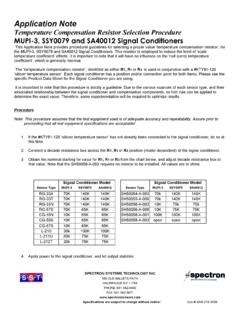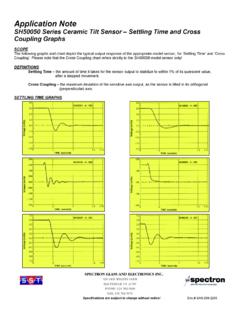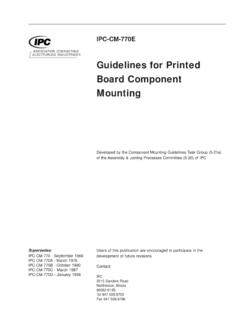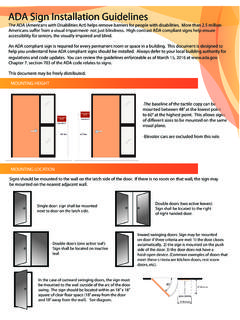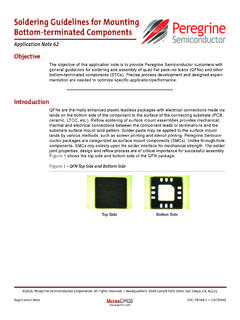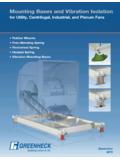Transcription of Application Note SH50050 Series Ceramic Tilt Sensor Π...
1 Application Note SH50050 Series Ceramic Tilt Sensor installation guidelines and thermal considerations SPECTRON GLASS AND ELECTRONICS INC. 595 OLD W ILLETS PATH HAUPPAUGE NY 11788 PHONE: 631 582-5600 FAX: 631 582-5671 Specifications are subject to change without notice! Doc.# SAN-204-3708 OVERVIEW The purpose of this document is to provide installation guidelines and general signal conditioning requirements for the SH50050 Series Ceramic Tilt Sensor . Two methods of installation , mechanical and adhesive bonded , will be detailed.
2 Please note that failure to follow these instructions as stated can result in sub-standard Sensor performance and/or irreparable damage!! Mechanical installation Method MOUNTING SURFACE REQUIREMENTS The surface to which the Sensor will be mounted must be in the vertical plane, and have a flatness of .010 ( ). Attempting to mount the Sensor to a surface that exceeds this flatness specification will cause the Sensor to flex beyond it s yield point during torquing, resulting in irreparable physical damage. If the stated mounting surface flatness cannot be achieved, a SPECTROTHERM 7 compressible insulating plate may be used on the rear face of the Sensor to compensate.
3 See diagram and chart below for proper positioning and part number. see thermal considerations for more information Sensor Model SPECTROTHERM 7 p/nSH50054 SH50258 SH50055 SH50258 SH50056 SH50294 SH50058 SH50295 MOUNTING HARDWARE All sensors must be mounted using the proper size machine screws and washers to insure a proper installation . Please see chart below. Using these screws and washers will insure that the clamping force is distributed over a large enough area to prevent damage to the Sensor .
4 Sensor Model Screw Size Washer SizeSH50054 #2-56 (M2) #2 (M2) SH50055 #2-56 (M2) #2 (M2) SH50056 #2-56 (M2) #2 (M2) SH50058 M1 M1 Note: M2 is the acceptable metric substitute for #2-56 TORQUE SPECIFICATION Regardless of the model, all screws are to be tightened to 60 inch-ounces (425 Newton-mm s), using a properly calibrated torque wrench. For the SH50056 Sensor , which has four mounting holes, tighten the screws in a diagonal pattern. WARNING: Do not use any type adhesive or bonding agents between the Sensor and the mounting surface when using the mechanical (screw/washer) mounting configuration!
5 ! Adhesive Bonded Method ADHESIVE TYPE The adhesive bonded installation method is accomplished using a specific type adhesive compound, selected for its particular characteristics. Ordering information is as follows: Manufacturer = Bacon Industries Adhesive = LCA4 Activator = BA5 Application Note SH50050 Series Ceramic Tilt Sensor installation guidelines and thermal considerations SPECTRON GLASS AND ELECTRONICS INC. 595 OLD W ILLETS PATH HAUPPAUGE NY 11788 PHONE: 631 582-5600 FAX: 631 582-5671 Specifications are subject to change without notice!
6 Doc.# SAN-204-3708 installation The keys to a successful installation are proper surface preparation, and a minimal amount of adhesive properly positioned on the rear face of the Sensor . Before starting, clean both the mounting surface and the rear face of the Sensor with alcohol and a cotton swab. Let dry thoroughly. Mix the adhesive and activator per the manufacturers instructions. The diagram below shows the rear view of the various model sensors, and the exact area where the adhesive is to be applied. Apply a small dot of adhesive not more than .050 in diameter to the indicated position on the rear face of the Sensor .
7 Place Sensor against the mounting surface, and clamp in place using a spring-loaded clothespin. Let adhesive fully cure per manufacturers instructions. WARNING: Never apply more adhesive than instructed and/or in areas other than indicated above. Do not apply excessive clamping forces during curing, as either condition can cause irreparable damage!! thermal considerations The SH50050 Series Ceramic Tilt Sensors constructed out of a 96% Alumina Oxide material, which has a thermal conductivity of 66x10-7/degree C. This aids dramatically in reducing the thermal settling time needed to stabilize its quiescent temperature.
8 However, this characteristic also makes the Sensor very susceptible to thermal gradients. Depending on the Application , internal heat generation and external thermal operating conditions, the Sensor can either be hard mounted to a thermally conductive material such as aluminum or copper, which will act as a heat sink, or insulated using a SPECTROTHERM 7 compressible insulating plate to reduce its susceptibility. When using the Sensor close to a high heat source (such as a HeNe laser tube), every effort should be made to evenly distribute the heat and reduce end-to-end thermal gradients on the Sensor . The symmetrical geometry of the Sensor aids in this regard, by creating a uniform distribution of the ambient temperature, which in turn creates an even change in the sensors internal fluid volume.
9




